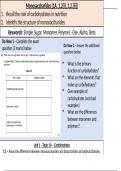Presentation
Structure-of-Monosaccharides
- Module
- WBI1/6BI0 (6BI0)
- Institution
- PEARSON (PEARSON)
The PowerPoint presentation titled "Structure of Monosaccharides" provides a comprehensive overview of the fundamental components of carbohydrates. It delves into monosaccharides, the simplest form of carbohydrates, highlighting their molecular formula (CH2O)n, structural isomerism, and classificat...
[Show more]












